
25 minute read
Headlights
Plan to Succeed
The future is never far away. If we want to control our destiny and be successful, we need to anticipate and plan for it. Mack Trucks constantly plans for the future, investigating new trends and technologies, potential changes in regulation and looking at the economy. We put those plans into action with new products like the Mack® LR Electric refuse truck and Over the Air to meet the new demands the future brings.
Decisions for the future require information in the present. We’re in a dynamic industry in the midst of ongoing rapid change. Fleet managers need information to make the best operational choices. Drivers have access to detailed vehicle performance information in real time. Even our Mack trucks, still as tough and durable as ever, can now be looked at as connected devices, providing a constant stream of data.
Bulldog magazine also provides its own stream of information. The cover article for this issue is our attempt to predict what may happen in the next few quarters by looking at industry, economic, regulatory, equipment and technological trends, to help our customers better understand the outlook for their business. The On Business article focuses on another profitable use of information, which is to reduce insurance costs for fleets. Technology, such as management systems enabled by Mack GuardDog® Connect, helps generate and provide this data and smart operators use it to improve safety and lower costs. As always, we have profiles of tremendous Mack fleets in this issue. This time around we look at H&K Group, which recently celebrated its 50th anniversary and has always had a deep relationship with the Mack brand. Santmyer Transportation is an enthusiastic adopter of the Mack Anthem® and has grown from a small business to the largest fuel distributor in its region. And ML Crane Group uses its customized Mack Granite® tractors to haul enormous cranes and oversize loads all over the country.
We also take a deep dive into the rugged world of snowplows, to demonstrate how Mack plows keep the roads clear and traffic moving, no matter the conditions. And we take a look back at the early days of refuse collection as Bulldog examines the “Keeping America Clean” special exhibit at the Mack Trucks Historical Museum, with its vintage refuse trucks provided by Republic Services.
The trucking industry looks very little like what it was when those vintage trucks were the new tech of their day. a generation ago. But, as always, Mack will be listening to its customers and planning for our shared future. That’s a long-term trend that Mack will continue.
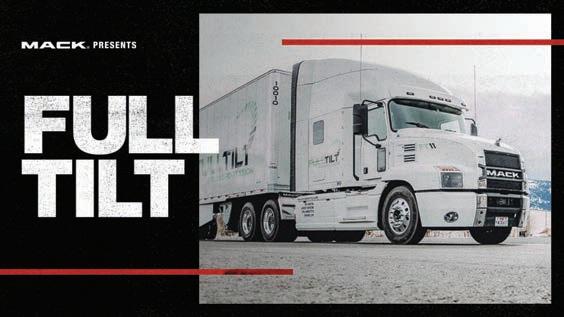
Full Tilt Logistics takes on the challenge of building a modern logistics business from the ground up in Episode 2 of “RoadLife 2.0.” The series picks up from last season, sharing the stories of everyday people doing extraordinary things.
Mack Trucks’ ‘RoadLife 2.0’ launches new season
Mack Trucks’ “RoadLife 2.0” is on the air with four new episodes on roadlife.tv, with more to come. The first two episodes feature the grueling efforts of Alaska Department of Transportation snowplow drivers to clear one of the snowiest highways in the U.S. and the challenge of building a modern logistics business from the ground up.
The third episode highlights the integral role Mack® trucks play in the success of Westcan Bulk Transport, one of western Canada’s largest bulk transportation providers. With more than 1,200 employees operating across 16 locations. Mack trucks make up the majority of Westcan’s fleet of more than 700 power units, including the new Mack Anthem® model.
The Richardson Highway is the only road in and out of Valdez, Alaska, the terminus for the Trans-Alaska oil pipeline. Alaska DOT keeps it open with its Mack Granite® snowplows.
Reno, Nevada-based Full Tilt Logistics is featured in the second episode and takes the meaning of a family business to the next level. Starting with just three trucks, the Novich family quickly grew the business into a 16-truck fleet. Full Tilt relies on their growing Mack Anthem fleet to thrive and attract a waiting list of drivers.
“Our number-one customer is the driver. If we keep them happy, they will want to come work here,” says Cris Novich, managing director, transportation for Full Tilt.
The most recent episode focuses on TransLand, known for being a premier transportation company in the U.S. While many trucking jobs have their own rewards, TransLand offers a career that goes beyond just a paycheck to help them attract the most committed employees.
View new episodes of “RoadLife” on roadlife.tv and Amazon Prime Video, with additional content featured on Mack Trucks’ social channels: Facebook, Twitter, Instagram, LinkedIn and YouTube.

Mack Masters champions demonstrate Mack know-how
Team #RiseForTheAnthem was named champion of the 2019 Mack Masters Competition. The aftermarket team from Bruckner Truck Sales in Shreveport, Louisiana, completed several rounds of challenges designed to evaluate their knowledge of Mack® service systems. Team #RiseForTheAnthem’s superheroes of service are Justin Malone, Joey Wardrip, Aaron Toomer and Ted Pfi ster.
Mack Trucks builds 100,000th Mack® GuardDog® Connect truck


Mack Trucks reached a signifi cant milestone in its connected truck journey by building the 100,000th truck equipped with its Mack® GuardDog® Connect integrated telematics solution. “From its launch with truck number one to now reaching 100,000 trucks, Mack GuardDog Connect has proven itself to be an incredible tool to protect and maximize our customers’ uptime,” says Jonathan Randall, Mack Trucks senior vice president, North American sales and marketing. “We’re proud to have reached this milestone and look forward to continuing to build on our uptime leadership with GuardDog Connect.”
Mack GuardDog Connect also serves as the enabling technology for Mack Over The Air, which provides remote software and parameter updates directly to customers’ trucks. Working with Mack OneCall agents, updates are scheduled at the customer’s convenience. Should a customer require frequent parameter updates, including changes to road speed limits, idle times, engine performance modes and more, a Mack Parameter Plus package allows customers to make up to 50 parameter updates per truck, per 12-month period.

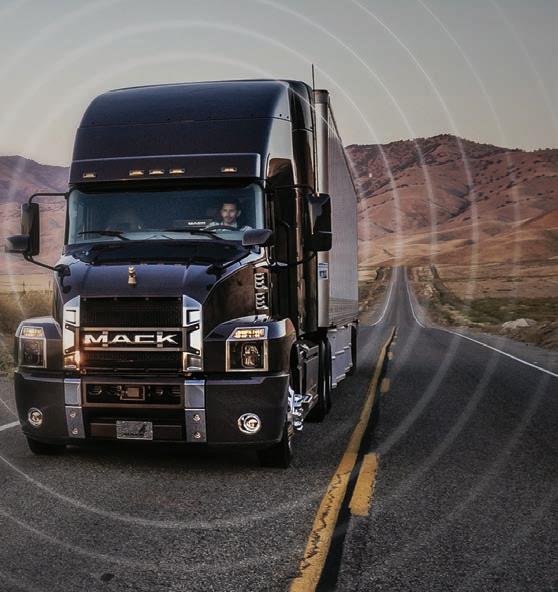
Mack Trucks dealer Kriete Truck Centers has invested $6 million in a new building, doubling the number of service bays at the Racine, Wisconsin, facility. The Mack® Certifi ed Uptime Dealer location will also add a mezzanine in October to double its parts warehouse capacity. “The new expansion enables Kriete Truck Centers to better serve their customers, providing the high level of support truck owners have come to expect from a Mack dealer and a Mack Certifi ed Uptime Dealer,” says Jonathan Randall, Mack Trucks senior vice president of North American sales and marketing. The original facility opened in 2005 and offers $2 million in parts inventory. It now consists of two buildings, one of which is the new 25,000-square-foot expansion, designed to extend Kriete’s management of concrete pump service and support its work with Putzmeister, a global leader in concrete, underground, mortar and industrial technologies. Kriete’s new building expands the dealer’s retail service and body shop business to include collision repair and body painting, doubling its previous capacity. The new paint booth measures 85 feet long, 22 feet wide and 22 feet high, ideal for handling concrete pump equipment, such as the Mack TerraPro™ or Granite® models equipped with Putzmeister concrete pump bodies. The facility has 15 bays, and Kriete plans to add 40 service technicians to manage the workload. “It’s one of Kriete Truck Centers’ core missions to be the very best steward of the Mack Trucks brand,” says David Kriete, president and CEO of Kriete Truck Centers. “This expansion provides a state-of-the-art facility to better serve Kriete and Mack network customers to keep them on the road and help their businesses remain successful.”
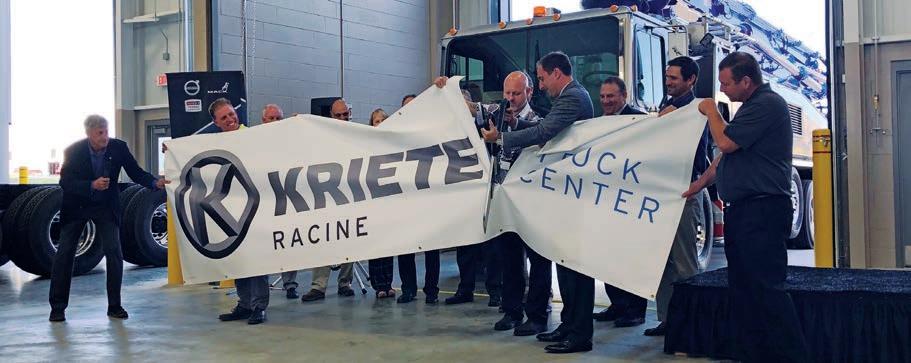
2020 vision
A look at trends expected to shape the trucking industry over the course of the next year.
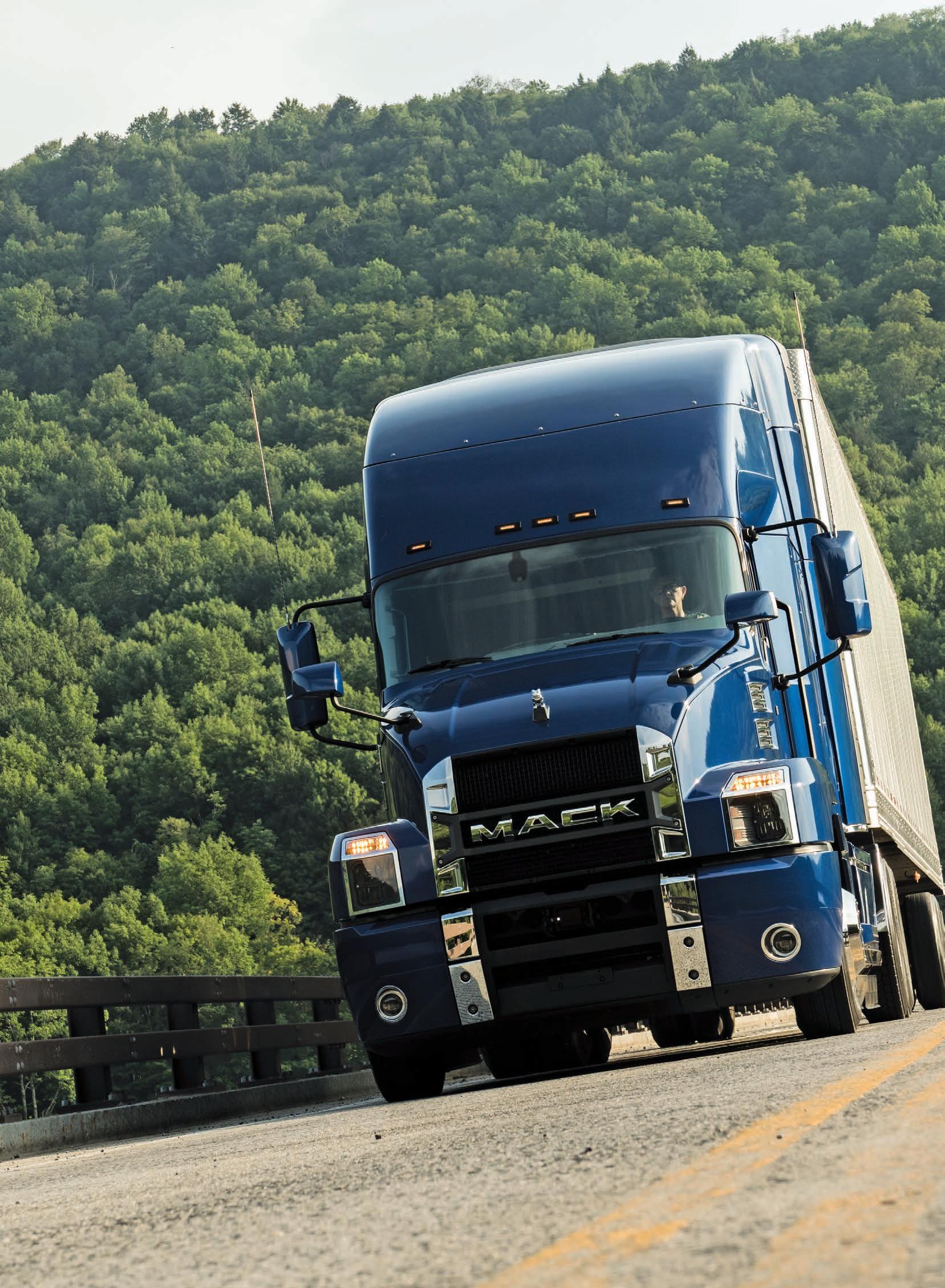
By Olivia McMurrey
Many highway fleets are using telematics and predictive maintenance to help balance rising costs.
While forecasters predicting economic trends for 2020 are sending mixed messages, we called on transportation insiders and Mack Trucks officials to help bring the business outlook for 2020 into focus. Here are their views on the economy, trucking-industry market trends, technology, the driver shortage, regulations and more.
Economic signals
food-grade commodities, says a contractContradictory indicators and a looming presi- shipping strategy has worked well for his dential election are hampering clear eco- company. “If you don’t have any direct nomic predictions. accounts and you just work through a broker,
The U.S. unemployment rate fell to 3.6%, chances are you’ve seen your rate per mile the lowest level since 1969, earlier this year, drop significantly and your business drop and consumer spending remains strong. off,” Keller says. According to a National Association of In short, this is because freight capacity has Business Economics’ survey of professional loosened despite freight volumes remaining forecasters as reported by Fortune magazine, strong. High rates in 2018 prompted fleets to the U.S. economy is slated to grow at 2.6% expand and encouraged owner-operators to through 2019, then slow to 2.1% in 2020. A enter the market, leading to more trucks on majority of those forecasters, however, think the spot market in 2019. a recession is possible “We feel like we’ve before 2021. An been able to, for the inverted yield curve for most part, stand pat U.S. Treasury bonds is “You have very from last year,” Keller fueling unease. Trucking-industry strong record says with regard to shipping rates. “There’s gauges are disparate performance in no question there’s a as well. Freight vol- little bit of softness, but umes in many seg- 2019 that’s moving our customers seem to ments are up, but rates are not. Average signback toward the be in lockstep with the consumer-driven econing bonuses have good/normal omy, and we are seeing decreased, yet the the consumer being number of carriers range.” strong. So I think that’s offering bonuses has helped us quite a bit. stayed high. Through a Abraham Davis, director of market “My guess is the next Bibby Transportation intelligence for Mack Trucks six months are going to Finance survey of 250 be good. And then trucking businesses after that, all bets are with between 1 and 100 trucks, 38% of off. When there’s a presidential election comrespondents reported they expect to continue ing, businesses kind of tread water until the growing at 11%-25%, while 66% recounted elections are over.” losing a contract in the past year to a competitor offering unprofitable prices. Abraham Davis, director of market intelli- Trucking industry gence for Mack Trucks, says the current eco- market trends nomic view is being influenced by exceptional performance in recent years. “GDP [gross Customers are appreciating that trucks are domestic product] is still solid,” he says. “You more efficient than ever, and the new engines have very strong record performance in 2019 and emissions equipment have proven themthat’s moving back toward the good/normal selves with years of real-world operation range. When you look at year-over-year, indi- Local requirements will lead to smaller “last cators look worse, but fundamentals are mile” trucks and potentially electric trucks in actually solid.” inner-city applications in coming years,
Most Mack customers expect a slowing- Randall says. He also says electronic logging but-strong economy, says Jonathan Randall, devices and continued expansion of the hubsenior vice president of sales and marketing and-spoke model — where a central hub (disfor Mack. Customers’ biggest concerns, tribution center) is connected to freight lanes aside from a looming slowdown, continue to running along “spokes” — means the daybe driver retention and, for highway custom- cab business will become a larger portion of ers, shipping rates not keeping pace with the truck-sales market in the near future. increased costs. “One of the largest builders of brick and mor-
Joe Keller, president of Marvin Keller tar in the United States right now is also the Trucking, a regional carrier based in Illinois No. 1 online retailer,” Randall says. “And they and operating 120 tractors to haul mainly just started a fleet of trucks. Other traditional
retailers who are seeing more of their revenue come from online retail, like Walmart, also have their own trucks. So the big retailers are either already in, or considering getting into, the trucking business.”
This means truckload carriers currently operating on tight profit margins are going to be squeezed. “They’re going to have to figure out ways to operate at a better efficiency and be more competitive with Amazon or a similar company who thinks they can do it cheaper themselves,” Randall says.
On the positive side, more hub-and-spoke operations might ease challenges associated with driver recruitment and retention, since drivers will be home every night.
Last-mile delivery is another area where big change is expected, but whether robots, drones or another technology/method emerges is uncertain. Randall says he doesn’t foresee significant changes with last-mile delivery in the next year. “I don’t think there’s going to be one watershed moment that makes it gel one way or the other, but it’s going to be ongoing investment and validation,” he says.
Innovation and technology
Two factors — safety and reduced operating costs — are driving technological innovations in commercial trucks. “And in that order,” Randall says. “We’re asking, ‘What can autonomy mean for safety?’ And ‘What can Over The Air and uptime mean for operating costs? Not only for the drivers, but for the general public?’ And then, ‘What does it mean for customers’ operating costs?’”
Most truck owners in the construction segment expect to maintain steady growth in 2020.
Automation
Mack’s highway models, the Mack Anthem® and Mack Pinnacle™, both come standard with the Bendix® Wingman® Fusion™ system, which provides collision mitigation, adaptive cruise control and lane departure warnings. Fleet, driver and general-public views of increasing truck autonomy are mixed. “Generally, larger fleets are leading the charge with adoption of advanced technology such as automation” Randall says. “Some of our customers believe level four autonomy is the future for them in a big way for safety. Does that mean having a human and the cab? Most likely. But no feet, no hands” he says, referring to hands-free driving and automated braking, also known as Advanced Driver Assistance Systems or ADAS.

Predictions for trucking-industry market segments
Unique forces are impacting the on-highway, construction and refuse segments of the trucking industry. We delve into their effects below.
Refuse
Mergers and acquisitions and changes in recycling markets are the major trends that will affect the refuse industry in 2020, says Curtis Dorwart, refuse product manager for Mack Trucks.
While mergers and acquisitions are a positive indicator for business, they aren’t equally advantageous for all those in the refuse industry. “A lot of the smaller guys are getting absorbed by the larger players,” Dorwart says. For the bigger companies, this means increased leverage when negotiating prices for trucks and truck bodies and when discussing rates with their customers. For smaller companies, it adds pressure to find different ways to compete. Because they might not be able to match or beat a larger company’s rates, they could provide a higher level of service or offer recycling services not provided by the competition, Dorwart says. In some areas, symbiotic relationships are emerging. For instance, a large company fires an outlying customer because of low profit margins and a smaller company takes on that customer and does well with it.
Foundational shifts in the recycling market are underway and are making it difficult for U.S. municipalities and refuse companies to turn a profit in this arena. In the past, most plastic going into American recycling bins was baled up and sent to China in empty shipping containers that had been used to bring Chinese goods to the United States. But with the rise of a Chinese middle class, China is generating its own used plastics. As a result, the price China pays for American plastic has dropped significantly, and the Asian nation has placed strict cleanliness requirements on U.S. products. This situation means the refuse industry in the United States is struggling to find solutions. Among the possibilities, Dorwart says, are developing a domestic industry for cleaning up and/or recycling plastics, lowering processing costs with better sorting technology and returning to multiple-stream recycling, in which consumers must sort their recyclable waste into separate bins.
From time to time, the waste stream changes significantly (when printed newspapers declined, for example), and now the “Amazon effect” has vastly increased the amount of cardboard in the system, Dorwart says. Luckily, China is still keen on importing
“The bigger hurdle, I think, for autonomy is not going to be whether the technology is ready but whether the general public is comfortable and the legislation is able to keep up,” Randall continues.
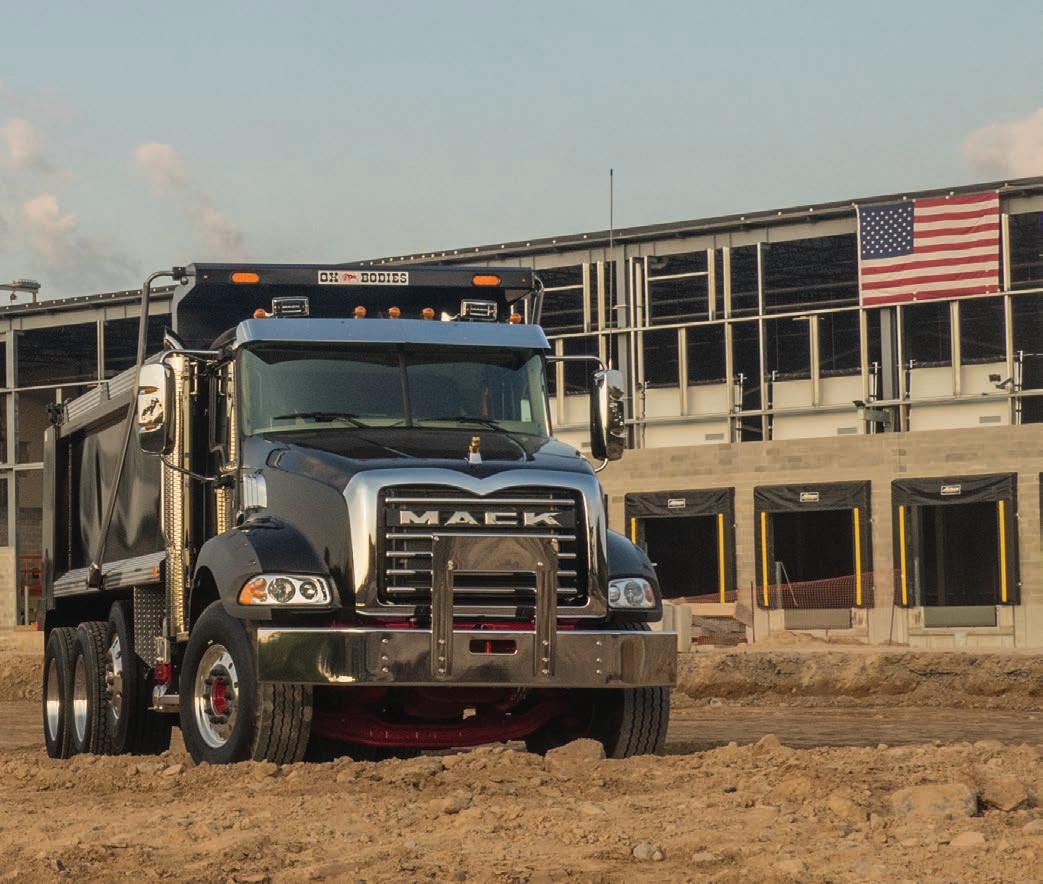
Connectivity
Truck connectivity has exploded in recent years, and that trend will continue.
The most recent innovation, Mack® Over The Air, launched in 2017 and expanded in 2018, delivers software updates and vehicleparameter changes anywhere in the United States and Canada where a cellular connection is available. By using OTA, fleets can compress the amount of time required to update software or vehicle parameters from a day or more out of service to as little as 20 minutes in the fleet’s yard.
Truck owners also can use Over The Air to make their own changes, including adjustments to speed governors and the way the transmission engages at different speeds. All these capabilities reduce dealer service fees and increase revenue by preventing downtime.
“Idle settings are going to be a big one for us, and that’s a tremendous flexibility that we really appreciate,” in addition to the cost savings, Keller says.
paper and cardboard due to its poor timber industry. “So that will continue to be a little bit of a bright spot,” Dorwart says.
Construction
Relative to their counterparts in other truckingindustry segments, those involved in construction are feeling more confident. Tim Wrinkle, construction product manager for Mack Trucks, says truck owners in the construction segment expect to maintain steady growth in 2020. Two big influencers — infrastructure spending and private construction — are stable, Wrinkle says. “A whole lot of warehouses are being built with the trend toward e-commerce,” he says. “Having more goods closer to customer endpoints is really driving that. And it’s a lot of concrete being poured.” Such construction also entails site-prep work and road building.
Truck-related trends include maximizing payload to improve efficiency and using telematics for scheduling. Mixer-truck owners are adding lift axles and different configurations. Whereas a 10-yard barrel was typical in
photo: Jim McNamara
the past, 12-yards are common now in states where they’re allowed. In the same vein, dump-truck operators are choosing lightweight bodies to increase haul capacity.
One of the most advanced areas for telematics is time-sensitive mixer-truck applications. Once the product is onboard, the driver has only 90 minutes to unload it. Owners are using GPS not only for location data, but also to check which way the barrel is turning. This tells them whether the truck is maintaining or discharging concrete. Sensors also can track how much water is added to the concrete while it’s in the truck. Adding water can lengthen shelf life, but lowers quality.
On-highway
Stu Russoli, highway product manager for Mack Trucks, says a lot of regional- and longhaul trucking companies are looking at upgrading their fleets, and he doesn’t think that would be the case if they were overly worried about a possible economic slowdown. “We see the overall market volume going down a little bit, but I don’t think that reflects that people aren’t optimistic,” Russoli says. “They just may have already bought so
Jonathan Randall, senior vice president of sales and marketing for Mack Trucks
Electric trucks
Electric trucks also are in the cards, and Mack is leading the way with the all-electric
much that it’s slowing up, which it has to do at some point. As far as the customers I’ve met with, they’re going out to buy and they’re not being shy about it.”
Most highway customers are interested in addressing the segment’s chief concern — expenses rising faster than shipping rates — with telematics. Maintenance and fuel savings can help balance driver pay and benefits increases, but companies need data and efficient trucks and service to make this work. Many fleets used to do maintenance on all their trucks at the same time intervals, Russoli says. Telematics allows fleets to take a smarter approach. “You’ll have a telematics chart coming in and you’ll know, for instance, one truck’s running a lot more or has more idle time,” he says. “So you can manage maintenance better and actually do what is needed because you’re looking at the mileage and the hours on the engine.”
Mack Over The Air updates are another way to cut maintenance costs since software updates and parameter changes can be conducted without bringing trucks to service centers and losing half a day or more of productivity.
Mack® LR refuse truck. The New York City Department of Sanitation and Republic Services, a waste collection company based in Phoenix, Arizona, will be testing demonstration models in 2020.
“We believe this is the right industry to test this technology,” Randall says. “It’s rugged, it will test the battery density and will test the batteries’ ability to manage parasitic load while still meeting demand for propulsion, and it will lead to further development in other of our equipment.
“Our belief is that hub-and-spoke, citydelivery and stop-and-go applications, and maybe even some regional haul, make the most sense for fully electric trucks.”
Davis says while there is still a market for alternative fuels such as natural gas, the industry is moving toward electric technology.
Service and body installation with an electric powertrain versus a gas- or dieselpowered truck also will be completely different, Dorwart says. “We’re using these first couple of vehicles as a learning experience both for customers as well as us,” he says. “There’s a huge learning curve and a huge training requirement that’s going to have to take place in the industry as electric propulsion systems develop.” Electrification of some truck systems, such as auxiliary power units, is also expected to increase.

What drivers want
Even with freight capacity and freight volume lining up better this year, labor remains a top concern throughout the industry. According to the American Trucking Associations, the driver shortfall is expected to decrease slightly from 2018’s peak of 60,800 to 59,500 by the end of 2019, due to slower economic growth and a small bump in supply.
Because of the labor shortage, drivers are influencing the equipment that fleets are buying, Randall says.
Marvin Keller is spec’ing trucks with creature comforts and conveniences. For instance, all the Mack Anthem® models the company recently purchased include refrigerators.
Safety features and other types of technology also are attracting younger drivers, Keller says. “Millennials don’t question technology, they expect it,” he adds. “And actually, the more complicated, the better. They’re more techie and gadgety.”
Mack has noticed this tendency as well, and trucks are beginning to reflect it.
“The next generation is used to working with screens,” Randall says. “They’re used to working with a lot of data and stimulation. So, as we design our cabs and trucks going forward, we’re designing them to interact in a way that today’s generations interact with their devices.”
Features that make getting into the
Mergers, acquisitions and changes in recycling markets will continue to affect the refuse industry.
trucking profession easier and assist carriers with onboarding are gaining popularity as well. The prime Mack feature in this arena is the mDRIVE™ automated manual transmission.
Since the mDRIVE was introduced, its acceptance rate has soared, and it’s now available in highway and construction models. Currently, the take rate is greater than 90% in the Anthem highway model and greater than 70% with the Pinnacle model. More than 80% of Mack Granite® models sold have automated transmissions.
“The manual transmission is in the minority now for sure,” Randall says. “And if you had told me 15 years ago that would be the case, I would have said you were nuts. But now we’re proving it. This advancement has done
Mack order trends
Launched in 2018, the new Mack Anthem highway tractor was a fullscale redesign of the previous highway product. The Anthem’s features and style have garnered Mack new customers, including Marvin Keller Trucking, which purchased 17 Mack Anthem models. “We’ve got reorders from the first of the early adopters of the Anthem — not only the customers we already had, but also the customers that we’ve gained,” says Jonathan Randall, senior vice president of sales and marketing for Mack Trucks. “As a result, we’ve seen a bump in our market share in the long-haul segment.”
Anthem has been extremely successful in both the regional- and long-haul markets. In addition to carrying on Mack’s reputation for reliability, durability and cutting-edge technology, the Anthem has been lauded for the attention designers paid to driver comfort and convenience — details that help customers attract and retain drivers. The stand-up
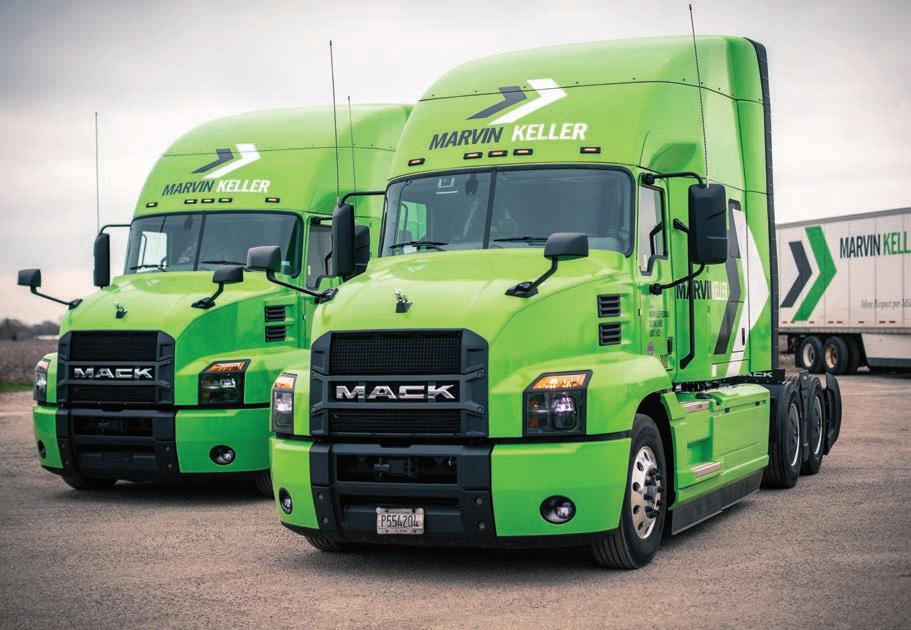
Marvin Keller Trucking, a new Mack customer, recently purchased 17 Anthem models.
sleeper is particularly popular.
The Granite®, Mack’s industry-leading vocational offering, and the Pinnacle highway tractor both sport redesigned interiors that incorporate the Anthem’s ergonomic and driver-friendly features.
a really good job of opening up the driver pool and allowing less experienced drivers to learn the trade.” More traffic congestion also has contributed to the shift away from manual transmissions since stop-and-go conditions increases fatigue when drivers have to push the clutch pedal and shift gears.
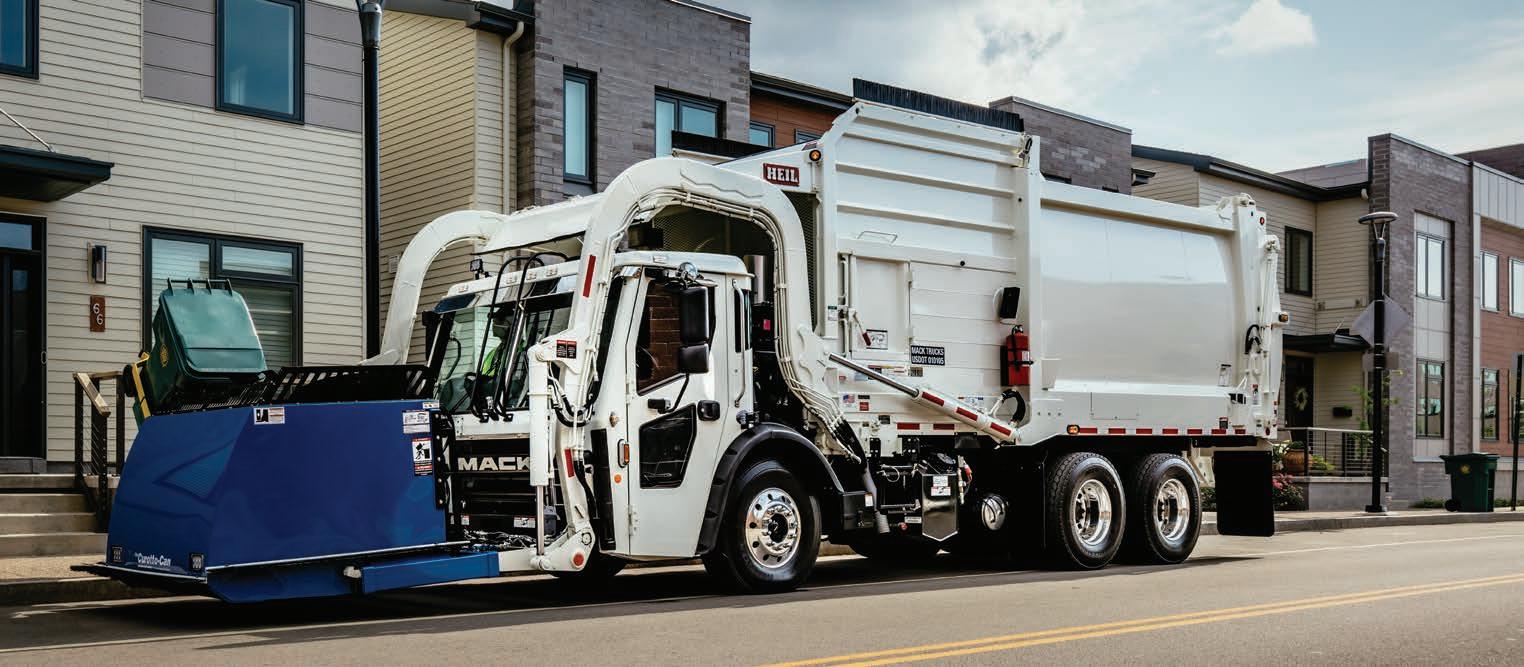
Regulations
Several recent or upcoming regulatory changes will affect trucking businesses in 2020.
Time over money
do something local for a day. And then that’s a full week for them. Those are some of the things we’re experimenting with.” Drug and Alcohol Clearinghouse “We’ve found that In 2020, the driver Marvin Keller is work- shortage could be ing on several methods for many drivers, exacerbated by for achieving another goal of its driver money is not their FMCSA’s CDL Drug and Alcohol recruitment and reten- top thing; home Clearinghouse, set to tion strategy: increased become operational in home time. time is. They want January. The The main tactics the company employs are to work less and Clearinghouse is a database employers operations and sched- be home more.” must query to identify uling adjustments. drivers who are prohibNoticeably absent from Joe Keller, president of ited from operating a its lineup are bonuses. Marvin Keller Trucking commercial motor “If you’ve got to pay vehicle based on DOT big bonuses for people drug and alcohol proto come to your com- gram violations. pany, then when another bonus is available, they’re just going to leave as quickly as they Greenhouse Gas Phase 2 came,” Joe Keller says. And besides, “We’ve Next year will see production of the first found that for many drivers, money is not heavy-duty trucks affected by Greenhouse their top thing; home time is. They want to Gas Phase 2 regulations, which set requirework less and be home more.” ments at the engine level and the vehicle level
Keller says a trend of fewer drivers staying to improve fuel economy and reduce harmful on the road a week or two at a time — a shift emissions. GHG Phase 2 standards take likely caused by the increased hub-and- effect in three phases that begin with model spoke activity discussed earlier — is making years 2021, 2024 and 2027. finding drivers who will take jobs with those Truck buyers will benefit from GHG Phase requirements more difficult. So Marvin Keller 2, Davis says. “They don’t pay more for less; is trying to manage its operations in ways that they are getting a more efficient vehicle,” he allow drivers to be home as much as says. “We don’t see it having a big impact on possible. the market.”
“It’s almost getting to the point where we might need two drivers for each truck instead ELDs: unintended consequences of one,” Keller says, adding other fleets are To help offset fewer hours driven because of considering this as well. “We’re seeing rota- stricter record-keeping due to electronic logtions where maybe a driver will only work ging devices, some fleets are lifting their road three or four days a week. And maybe they speed governors a few miles per hour,
photo: JSR Studio
something easily done with OTA. At the same time, customers are recognizing the need for enhanced aerodynamics and other systems, such as lift axles, to improve fuel consumption.
Hours-of-service proposal Most trucking-industry organizations, including ATA, Truckload Carriers Association and Owner-Operator Independent Drivers Association, are supportive of the hours-ofservice proposal FMCSA published in the Federal Register Aug. 22, opening a 45-day comment period.
Under the proposal, drivers would be able to pause their 14-hour on-duty clock for up to three hours, use a new split sleeper berth option of seven hours and three hours, have more flexibility surrounding the 30-minute break requirement and extend their on-duty window when faced with adverse weather and traffic conditions. The agency also suggested expanding the short-haul exemption, which would allow more drivers to avoid keeping duty-status records.
Infrastructure spending
In recent years, the need for federal infrastructure spending has, at times, been a rare area of agreement between Democrats and Republicans on Capitol Hill. Legislation deemed the “most substantial highway legislation in history” is making progress in the U.S. Senate. The five-year, $278 billion bill titled America’s Transportation and Infrastructure Act of 2019 cleared the Senate’s Environment and Public Works Committee in August.
The new legislation would replace 2015’s FAST Act, which expires in December 2020.
Randall says Congress might not approve the legislation until after the presidential election, but in the meantime, states are spending enough for infrastructure-related construction to remain robust next year.
Keller notes Illinois recently raised fuel taxes to help fund infrastructure projects. “It’s a good thing,” he says. “We can build some roads and bridges, repair others.”

